Menus
- Retest the brake
- Rubbers exchanged too late in the first test?
- Kawasaki Ninja ZX-10R suddenly extremely precise
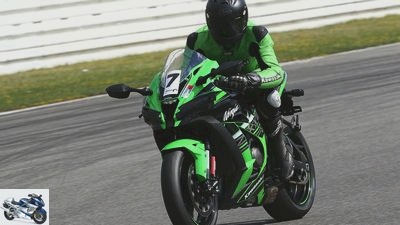
PHOTO-BK.COM
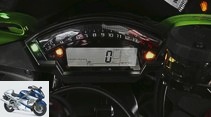
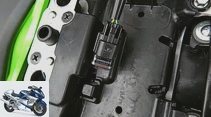
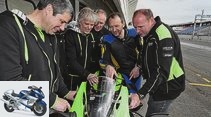
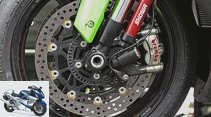
7th photos
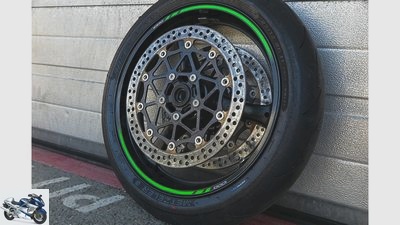
Benny Katzmer
1/7
The brake of the Kawasaki Ninja ZX-10R in the post-test.
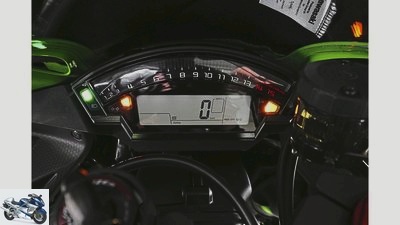
Benny Katzmer
2/7
At the bottom right of the display you can see which part of the ABS is currently deactivated. It works after switching the ignition off and on
automatically again.
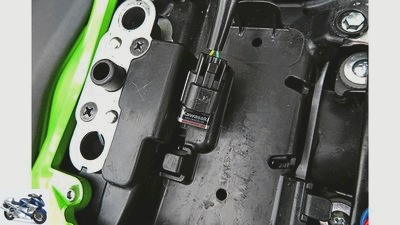
Benny Katzmer
3/7
On the right under the pillion seat is the plug for the dongle, with which the ABS can be deactivated. Highly recommended for the racetrack.
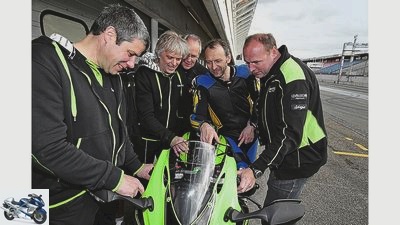
Benny Katzmer
4/7
Peter Schmidt and Andi Seiler from Kawasaki, Ralf Schneider and Uwe Seitz (MOTORRAD and PS) as well as Michael Resch from Kawasaki (from left). Here when traveling through the settings menu.
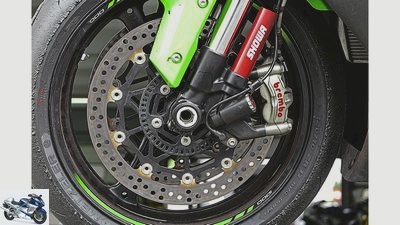
Benny Katzmer
5/7
Despite the visible heat load, the Brembo discs of the Kawasaki Ninja ZX-10R remained without warping and scoring. …
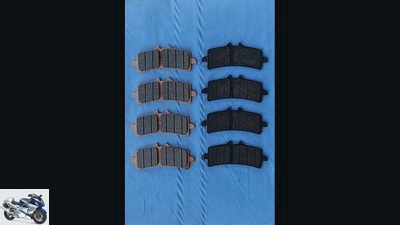
Benny Katzmer
6/7
… After completing the Aragon test drives, however, the pads were at the end (the right row), especially the upper one.

Benny Katzmer
7/7
Kawasaki Ninja ZX-10R.
Kawasaki Ninja ZX-10R in the compact test
Retest the brake
After the brake dosage on the Kawasaki Ninja ZX-10R received criticism and there were still a few things to clarify, MOTORRAD carried out another post-test.
Brakes are already a hot topic due to their design, and they were a particularly hot topic in the Superbike group test this spring (see MOTORRAD 8/2016). However, this was not only due to the high loads on the Aragon course. Because with the Kawasaki Ninja ZX-10R earned the brake dosage criticism. Apart from the fact that you brake more or less far into the curves on the racetrack, there are three corners in Aragon that are already approached in an inclined position.
Buy complete article
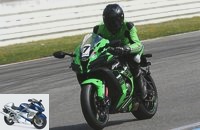
Kawasaki Ninja ZX-10R in the compact test
Retest of the brake
Ninja ZX-10R missed the genuine feeling for the interactions between the brake and the front tire. That came as a surprise to the testers because they had shone with precise feedback and controllability at the presentation in Sepang. There, however, with deactivated ABS.
Rubbers exchanged too late in the first test?
After the test machine had gone back to Kawasaki, MOTORRAD received a rebuke from there. The brake pads were almost completely worn out; this would have caused the doughy brake feel. The testers should have replaced the pads earlier, especially since they had a new set with them. It is true that the pads on the Kawasaki Ninja ZX-10R were ripe for a change after the final test drives. However, even the most heavily worn covering was not yet braked down to the carrier plates. It should be noted that the pad thickness at the start of the racetrack test the day before was certainly still ample, but the feeling for the brake metering was by no means more precise. None of the testers noticed any differences between the not even half-worn and almost completely worn pads, not even Christian Kellner, who set the lap times for MOTORRAD.
So there were a few things to clarify, and Kawasaki made the test machine available again for a retest during javelin training in Hockenheim. With new tires and brake pads as well as the old and new brake discs. In early summer temperatures, the tires of the Kawasaki Ninja ZX-10R, which had to suffer from the cold asphalt in Aragon, did better. The brakes at Hockenheim, however, are subject to enormous stress, especially at the end of the Parabolica, where the brakes are slowed down from sixth to first gear. There, as well as in the braking zones in front of the Mercedes grandstand, the Sachskurve, the Nordkurve and before the entrance to the Parabolica, they certainly decelerated.
Kawasaki Ninja ZX-10R suddenly extremely precise
When Kawasaki mechanic Peter Schmidt, on the initiative of Uwe Seitz from sister magazine PS, inserted an electronic component from the racing kit and deactivated the ABS, it became clear how things could be much better. Suddenly, the Kawasaki Ninja ZX-10R could be braked extremely precisely to the turning point or to the apex of the bends. The “Sepang feeling” was there again; it was like feeling every single hole in the brake disks brush the pads.
The explanation for this lies in the special tuning of the ABS. If a high brake pressure is built up very quickly, the system activates the secondary circuit of the pressure modulator. To put it simply: it is already activated, although the front wheel of the Kawasaki Ninja ZX-10R is not yet locked. When the ABS is deactivated, the brake pressure acts directly on the pistons in the Brembo M50 calipers. The small electronics dongle is now freely available; it costs around 22 euros. It can be used to either shut down the rear wheel ABS or the entire system. Every time the ignition is switched off and on, the ABS is reactivated, but the operating permit expires when the dongle is inserted. So you shouldn’t use it in public transport. In addition, Kawasaki recommends replacing the brake pads for race track use when they are about halfway worn.
Related articles
-
Kawasaki Ninja ZX-10R after-test the brake
PHOTO-BK.COM 34 pictures Kawasaki 1/34 Kawasaki ZX-10R (2016). Kawasaki 2/34 Kawasaki ZX-10R (2016). Kawasaki 3/34 Kawasaki ZX-10R (2016). Kawasaki 4/34 …
-
Comparison test BMW S 1000 RR, Kawasaki ZX-10R and Yamaha YZF-R1M
22 images 1/22 BMW S 1000 RR, Kawasaki Ninja ZX-10R and Yamaha YZF-R1M. 2/22 Yamaha YZF-R1M. 3/22 BMW …
-
Comparison test Honda CBR 500 R, Kawasaki Ninja 400, KTM RC 390, Yamaha YZF-R3
r-photography.info 29 pictures r-photography.info 1/29 Honda CBR 500 R, Kawasaki Ninja 400, KTM RC 390 and Yamaha YZF-R3 in comparison test ….
-
Ducati 1299 Panigale S and Kawasaki Ninja H2 in comparison test
31 pictures 1/31 Left in the picture 197 HP and 145 Nm (Ducati 1299 Panigale S), on the right there are 200 HP and 133 Nm (Kawasaki Ninja H2) ….
-
Endurance test final balance of the Kawasaki ZX-10R
Bilski endurance test final balance sheet Kawasaki ZX-10R Too good to strip After 50,000 kilometers it is opened, looked inside and measured. So are the …
-
Honda CBR 300 R, Kawasaki Ninja 300, KTM RC 390 and Yamaha YZF-R3 in the test
Bilski 24 photos Bilski 1/24 If four race-proven testers grin happily ever after a day on the slopes instead of exhausted gasping for air, it could be…
-
Top test: Kawasaki ZX-10R old-new
Top test: Kawasaki ZX-10R old / new The double top test of the old and new 10 ninja The ZX-10R has never lacked power. But now the tens…
-
Track test BMW K 1200 R Power Cup Kawasaki ZX-10R
Rossen Gargolov Track test BMW K 1200 R Power-Cup / Kawasaki ZX-10R The Bavarians are coming So far, BMW has played a league lower with the Boxer Cup….
-
Aprilia Tuono V4 1100 RR, Kawasaki Ninja H2 and BMW S 1000 XR in the comparison test
Arturo Rivas Gonzalez 31 photos Arturo Rivas Gonzalez 1/31 Aprilia Tuono V4 1100 RR, Kawasaki Ninja H2 and BMW S 1000 XR. Arturo Rivas Gonzalez 2/31 And…
-
Kawasaki Ninja 300 and KTM RC 390 in the test
31 photos 1/31 KTM RC 390. 2/31 Comparison test Kawasaki Ninja 300 and KTM RC 390. 3/31 Comparison…